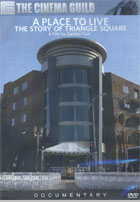
A Place to Live: The Story of Triangle Square 2008
Distributed by Cinema Guild, 115 West 30th Street, Suite 800, New York, NY 10001; 212-685-6242
Produced by Cynthia Childs
Directed by Carolyn Coal
DVD, color, 84 min.
Sr. High - Adult
Aging, Gay and Lesbian Studies, Gender Studies
Date Entered: 08/20/2009
Reviewed by Dan DiLandro, E.H. Butler Library, State University of New York College at BuffaloThe documentary A Place to Live: The Story of Triangle Square examines the building of the U.S.’s first affordable GLBT housing specifically for aging gay seniors. In documentary narrative format, the film follows not only the lives of seven gay individuals and their quest to obtain housing at Triangle Square, but also those involved in the planning and construction of the facility as well as elder gay advocates.
The film nicely synthesizes the experiences of the interviewees into a useful and educational narrative. The seven applicants explain their various and varied experiences growing up gay and how they now find themselves effectively alone. Indeed, the film makes clear the fact that the public perception of gay people – young, affluent, and surrounded by others – is often, and increasingly as the population ages, a myth. Too, the individuals’ stated lives provide some surprising and evocative points for viewers’ consideration. For example, one interviewee describes how during her formative years in the 1950s she was “groomed to be married.” As her latent homosexuality became apparent, she was forced into counseling (and accused of “hat[ing] your father!”) and ended by admittedly kidnapping her children and being forcibly institutionalized. Another subject notes his disgust with his own sexual orientation and his attempts within the “ex-gay” movement. Still others’ experiences are as useful for not only the glimpses that they reveal about past cultural attitudes toward homosexuality, but also how it is still perceived. Many of the interviewees, for instance, reveal that they have been “forced back into the closet,” as it were, since before the building of Triangle Square there existed no affordable housing for openly out seniors. Too, several of the subjects do not appear “old” as we have come to think of it; and this highlights the fact that many viewers will ultimately find themselves in, perhaps, similar circumstances.
Scenes regarding the fighting between the Gay and Lesbian Elder Housing organization and the Los Angeles Housing Authority are similarly evocative. There seems to be quite a bit of bigotry involved, but more obvious are the incredible levels of bureaucracy through which the film takes its audience. Underscoring that, the filmmakers describe the lottery process used to choose residents and the fair housing, non-preferential treatment standards necessary. The application process will provide viewers with a further view into the overall narrative and purpose of the film: The pre-application includes needed facts and data and leads at least one potential resident to worry that, “I don’t know what [the instructions] mean!” It is a confusing process that will be immediately recognizable to more viewers, again underscoring the “normality” of GLBT senior people.
Not all of the applicants win spaces in the new Triangle Square, and viewers are shown their respective dismay, but also their plans for the future. As one individual says, it is important to be “with [one’s] own kind…; and what other options are there until the nursing home…?”
Finally, the Gay and Lesbian Elder Housing group points out the success of the Triangle Square building and idea, hoping that this will provide a paradigm for the country. “[These seniors] should not have to lie and hide like they’ve been forced to do,” says the advocate. And ,em>A Place to Live: The Story of Triangle Square does a nice job of proving to audiences not only why they have had to, but also why Triangle Square in particular and advocacy overall is essential within our culture.
Overall, a somewhat “slight” film, but certainly very useful; and A Place to Live: The Story of Triangle Square is recommended for students of aging, gay and lesbian studies, and gender studies.
Awards
- Winner, Audience Award, Outfest, 2008